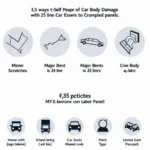Repairing paint damage on your car is essential, not just for aesthetics, but also to protect the underlying metal from rust and corrosion. This guide will walk you through various methods of repairing paint damage, from minor scratches to more serious issues, offering advice on DIY solutions and when to seek professional help. We’ll cover everything you need to know about tackling those unsightly blemishes and restoring your car’s finish.
Learning how to repair paint damage on car yourself can save you considerable money and maintain your vehicle’s value. We’ll discuss cost-effective solutions, from touch-up paint to more involved repairs. Whether you’re dealing with a minor scratch from a rogue shopping cart or more significant damage from a fender bender, understanding the repair process empowers you to make informed decisions. See our guide on the cost to repair paint damage on car.
Assessing the Damage: Know Your Enemy
Before you begin any repair, accurately assess the extent of the damage. Is it a superficial scratch, a chip that’s reached the primer, or a deep gouge exposing bare metal? The severity of the damage will dictate the appropriate repair method. Identifying the type of damage is crucial for choosing the right tools and techniques.
Types of Paint Damage
- Scratches: These are typically superficial, affecting only the clear coat or top layer of paint.
- Chips: These are deeper than scratches, often reaching the primer or even the metal beneath.
- Scuffs: These are often caused by rubbing against another object, leaving a mark on the paint surface.
- Fading and Oxidation: Prolonged exposure to sunlight can cause the paint to fade and oxidize, resulting in a dull, chalky appearance.
DIY Repair Options for Minor Damage
For minor scratches and chips, several DIY repair options exist. These can be effective and economical solutions. Always remember to work in a clean, well-ventilated area.
Touch-Up Paint: A Quick Fix
Touch-up paint is ideal for small chips and scratches. Carefully clean the area, apply the paint in thin layers, and allow it to dry completely. For a seamless finish, you can wet sand and polish the area after the paint has cured. You can learn more about repairing bumper damage at how to repair paint damage on car bumper.
Scratch Remover: Buffing Out Imperfections
Scratch removers are designed to remove minor scratches and swirl marks. Apply a small amount to a clean microfiber cloth and gently buff the affected area in circular motions. This can restore the shine and remove superficial imperfections.
How to Repair Clear Coat Damage?
Clear coat damage requires a slightly different approach. After cleaning the area, you can use a clear coat touch-up pen or spray. Multiple thin coats are recommended, allowing each layer to dry before applying the next. Check out our guide on repair damaged car paint.
When to Call a Professional
While DIY repairs are suitable for minor damage, more significant issues, such as deep scratches, dents, or widespread paint damage, require professional attention. A professional body shop has the expertise and equipment to restore your car’s finish to its original condition. Consider the how to repair paint damage to hook of car.
Signs You Need Professional Help
- Deep scratches or gouges that expose bare metal
- Dents or other body damage accompanying the paint issue
- Extensive paint damage covering a large area
- Rust or corrosion forming around the damaged area
“Addressing paint damage promptly prevents further deterioration and maintains the car’s value,” advises John Miller, Automotive Restoration Specialist at Miller’s Auto Body. “Ignoring even minor scratches can lead to rust and more costly repairs down the line.”
Preventing Paint Damage: Proactive Measures
Preventing paint damage is always better than repairing it. Taking a few precautions can help protect your car’s finish.
Regular Washing and Waxing
Regular washing removes dirt and grime that can scratch the paint. Waxing creates a protective layer that shields the paint from environmental factors.
Covered Parking
Parking your car in a garage or under a carport protects it from the elements, reducing the risk of fading, oxidation, and damage from falling debris. For those in sun-drenched areas, see our guide on sun damage car paint repair perth.
Conclusion
Repairing paint damage on your car is an important aspect of vehicle maintenance. From minor scratches to more significant damage, understanding the different repair options and when to seek professional help ensures that your car looks its best and retains its value. Addressing paint issues promptly and implementing preventative measures will keep your car’s finish in top condition for years to come.
FAQ
-
Can I use nail polish to repair car paint chips? While tempting, nail polish is not formulated for automotive paint and will likely not match the color or durability.
-
How long does touch-up paint take to dry? Drying time varies depending on the product and environmental conditions, but generally allow 24-48 hours for complete curing.
-
Can I wash my car after applying touch-up paint? Wait at least 24 hours after applying touch-up paint before washing your car.
-
How can I prevent bird droppings from damaging my car’s paint? Remove bird droppings as soon as possible, as the acidic content can etch the paint.
-
What is the best way to remove tree sap from car paint? Use a dedicated tree sap remover or rubbing alcohol to gently remove tree sap without scratching the paint.
-
How often should I wax my car? Waxing every three to six months provides optimal protection.
-
Can I repair a dented area myself? Minor dents can sometimes be repaired with DIY dent removal kits, but significant dents require professional repair.
Need more help? Check out our other articles on car repair. For immediate assistance, contact us via WhatsApp: +1(641)206-8880, or Email: [email protected]. Our customer support team is available 24/7.



